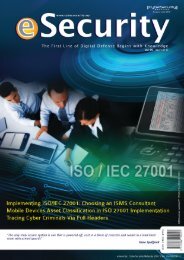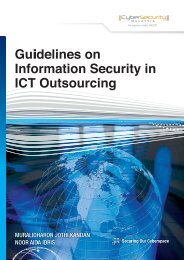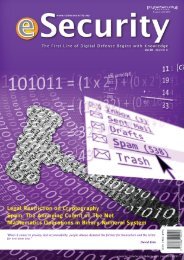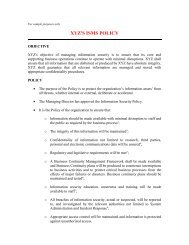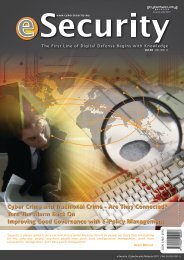Contributors - CyberSecurity Malaysia
Contributors - CyberSecurity Malaysia
Contributors - CyberSecurity Malaysia
Create successful ePaper yourself
Turn your PDF publications into a flip-book with our unique Google optimized e-Paper software.
From Figure 5, “0” or “1” is determined by the thresholdvoltage, Vt, of the cell. The threshold voltage can bemanipulated by the amount of charge put on the floatinggate of the flash cell. Placing charge on the floating gatewill increase the threshold voltage of the cell. When thethreshold voltage is high enough, around 4.0V, the cell willbe read as programmed. No charge, or threshold voltage< 4.0V, will cause the cell to be sensed as erased. SLCflash is used in commercial and industrial applications thatrequire high performance and long-term reliability. Someapplications include industrial grade Compact Flash cardsor Solid State Drives (SSDs).As seen in Figure 6, a flash cell’s ability to store charge iswhy MLC technology works. Since the delta between eachlevel has decreased, the sensitivity between each levelincreases. Thus, more rigidly controlled programming isneeded to manipulate a more precise amount of chargestored on the floating gate. In order for a flash cell to beconsidered MLC technology, the cell must exhibit twocharacteristics:flash by using the charge placement technology. Thus,MLC has greater densities. The read speeds between SLCand MLC are comparable. Reading the level of the flash cellcompares the threshold voltage using a voltage comparator.Thus, the architecture change does not affect sensing. Ingeneral, the read speeds of flash are determined by whichcontroller is used.The endurance of SLC flash is 10 times more than MLCflash. The endurance of MLC flash decreases due toenhanced degradation of Si. This is the main reason whySLC flash is considered industrial grade flash and MLC flashis considered consumer grade flash. Higher temperaturescause more leakage in the cells.Combined with the increased sensitivity required todifferentiate between the levels, this leakage will cause thesensors to read the wrong level. As a result, the operatingtemperature of MLC spans only the commercial range.Leakage is not significant in SLC flash and thus, it canoperate in an industrial temperature range.17.1. Precise charge placement2. Precise charge sensingConclusionThus, MLC flash works the same way as SLC flash. Thethreshold voltage, Vt, is used to manipulate the state ofthe flash. Once again, the amount of charge on the floatinggate is what determines the threshold voltage. As seen infigure 6, current MLC technology uses two bits, or fourlevels. However, it can hold more bits. Equation 1 is ageneric equation to determine how many states are neededfor the desired bits.Equation 1 States = 2NN is equal to the number of desired bits per cell. Forexample, for a cell to hold three bits, you need eight statesequal to: 000, 001, 010, 011, 100, 101, 110, and 111.MLC flash is used in consumer applications that do notrequire long term reliability such as consumer grade USBFlash drives, portable media players (PMP), and CompactFlash cards.SLC and MLC comparisonsSLCMLCDensity 16Mbit 32Mbit 64MbitRead Speed 100ns 120ns 150nsBlock Size 64Kbyte 128KbyteEndurance 100,000 cycles 10,000 cyclesOperatingTemperatureIndustrial CommercialTable 3: SLC and MLC comparisonsLet’s compare each characteristic in Table 3. Using thesame wafer size, you can double the density of the MLCTable 4 summarises the advantages and disadvantages ofSLC flash and MLC flash. •High DensityLow Cost per BitEnduranceOperatingTemperatureRangeLow PowerConsumptionWrite / EraseSpeedsWrite / EraseEnduranceTable 4: Qualities of SLC and MLCReferencesSLCMLC[1] http://en.wikipedia.org/wiki/Single-level_cell[2] http://www.supertalent.com/datasheets/SLC_vs_MLC%20whitepaper.pdf[3] http://forums.anandtech.com[4] http://www.flashbay.com/slc_mlc_usb_flash_drives.htmle-Security | <strong>CyberSecurity</strong> <strong>Malaysia</strong> | Volume 21 - (Q4/2009)



